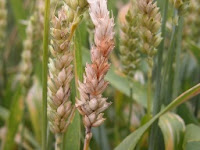Head scab may be a problem in your wheat.
-Sandra Wick, Crop Production Agent
Well, we have certainly been experiencing some crazy weather
around the area. From thunderstorms,
tornadoes and high winds to hail and torrential rains, the wheat has really had
some strikes against it. Although,
the rains have been a welcome site, with that has brought on stripe rust with
many fields having a fungicide applied.
Now there could be potential for fusarium
head blight or more commonly known as head
scab that might develop.
Scab is usually first detected soon after flowering and
infected heads turn white, while the leaves and stems may remain green.
Sometimes, the portion of the stem directly below the head can turn a chocolate
brown color. Often, only part of the head is attacked, giving heads a white and
green appearance. The outer covering
for the wheat kernel or the glume can be salmon-pink color and the scabby wheat
kernels are shrunken and chalky or pink in color as well.
The scab fungus infects not only wheat, but also corn, oats,
barley, and sorghum along with various
 So the recent rains along with forecasted high relative
humidity are the two most important ingredients that may initiate head scab
development.
So the recent rains along with forecasted high relative
humidity are the two most important ingredients that may initiate head scab
development.
Specific fungicides can suppress
the head scab infection from 35 to 50%, depending on the active ingredient in
the fungicide. The key word here is
“suppress”, which means reduces not eliminates or controls. There are very few wheat varieties that have
resistance to head scab. However, crop rotations that avoid planting
wheat into corn stubble may be
helpful in some years when favorable conditions are present. Seed treatments are just not effective in
preventing head blight, but they may
prevent seedling blight if scabby wheat must be used as seed. Several
commercial treatments may somewhat increase the germination of scabby seed. The
scabby seed should be cleaned very thoroughly and germination should be tested
prior to use. At harvest, the
percentage of scabby kernels can be reduced by setting the combine fans higher
during harvest. This will help blow the light, scabby seeds out the back of the
combine. Yield loss is related to the
percent of heads which are infected and the severity of the infection. Scab often causes reduction in test weight
and are counted as "damaged" in the grading process.
For further information on disease management in your wheat, contact any Post Rock Extension
District Office in Beloit, Lincoln, Mankato, Osborne or Smith Center.








